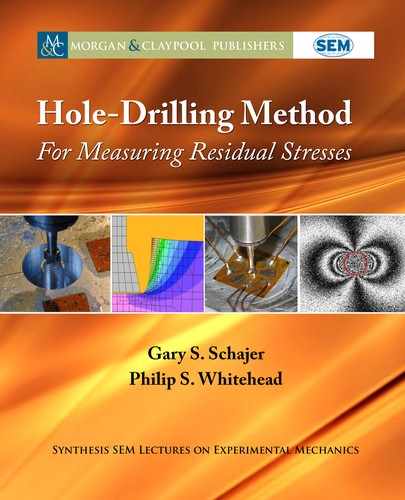
4.5. HOLE-DRILLING EQUIPMENT 77
can be glued to a work surface or base plate, or fixed using clamps. Care should be taken to
ensure that any clamping loads do not introduce spurious loads at the target site.
For “open” gauge rosettes, electrical connections are first made by soldering single-strand
conductors to the gauge elements (Figure 4.6a) and a remote solder terminal. Insulated, multi-
stranded leadwires then link the solder terminal to the strain recorder. For encapsulated gauge
rosettes, electrical connections are made by soldering insulated multi-strand leadwires to the
gauge (Figure 4.6b) for direct connection to the strain recorder. Micro-Measurements Appli-
cation Note TT-609 gives details of effective soldering techniques. It is recommended that the
wires should be as short as practicable and that three-wire temperature-compensating circuits be
used for each channel as described in Micro-Measurements Application Note TT-612. Shunt
calibration of the circuits can be used to determine the impact of overall leadwire resistance on
measured strains.
(a) Open gauge connections (b) Encapsulated gauge connections
Figure 4.6: Examples of target strain gauge installations and leadwire connections (photos cour-
tesy of Stresscraft Ltd.).
4.5 HOLE-DRILLING EQUIPMENT
e hole-drilling process is carried out using a specialized drilling guide or machine to align the
drill axis with the strain gauge rosette, to provide the appropriate rotary motion and to control
the drill depth. Readily available devices include the Vishay Micro-Measurements RS 200 and
SINT MTS3000 machines pictured in Figure 4.7. Both machines incorporate optical systems
for the alignment of the drill with the target center and for the measurement of the drilled hole
diameter. ey also incorporate dental-type air turbines for high-speed drilling. In addition,
both machines use manual screws for the adjustment of the drill position over the target site.
e SINT machine works in conjunction with a personal computer to control the plunge
(axial) drilling motion. A control panel and mouse/pointer enable selection of the drill increment

78 4. STRAIN GAUGE TECHNIQUE: METHOD DESCRIPTION
parameters and provide control of the acquisition and recording of strain data. e Vishay driller
is a “stand-alone” machine, where the drill feed is applied manually using a micrometer-type
collar around the drill barrel. Most importantly, this machine can be configured so that the
axis of the air-turbine is offset from the axis of the drill barrel. By rotation of the drill head
within the barrel, drilling proceeds in an orbital manner. is is similar to trepanning (or circular
milling) with a small eccentricity and can significantly enhance the quality of the hole forming
process in comparison to plunge (axial) drilling. Figure 4.7 illustrates the main features of the
two machines, while Figure 4.8 shows a schematic view of orbital drilling.
(a) Vishay Micro-Measurements RS-200
(reproduced by permission of
Micro-Measurements,
a Vishay Precision Group brand.)
(b) SINT MTS3000
(photo courtesy of Sint Technology s.r.l.)
Figure 4.7: Hole-drilling machines.
For orbital drilling, the speed of rotation of the drill barrel about the hole center (green
arrow) is, typically, less than 0.1% of that of the drill about its own axis (red arrow). e direction
of orbit rotation is a matter for experimentation to suit the drill geometry and specimen material.
e recommended drill for most specimen materials is the inverted cone type in tungsten
carbide. e inverted cone side profile provides clearance for the ejection of debris while avoiding
rubbing at the sides of the drilled hole. e end of the drill should be flat or slightly concave.

4.5. HOLE-DRILLING EQUIPMENT 79
Figure 4.8: Orbital drilling: a schematic view (photo courtesy of Stresscraft Ltd.).
Figure 4.9: Inverted cone dental burs (photo courtesy of Stresscraft Ltd.).
..................Content has been hidden....................
You can't read the all page of ebook, please click here login for view all page.
